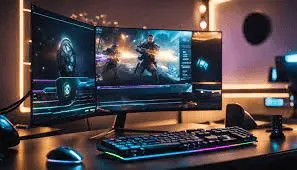Are you aware of the resolution bottleneck and its effect on PC performance? Below, we will explore how the resolution is set to avoid bottlenecks in PC for better performance.
Different resolutions affect CPU and GPU performance, which, in turn, affects the overall system. So, we will discuss the relationship between the resolution and a bottleneck. Optimizing the system is essential for enhancing your gaming experience.

What is the best bottleneck resolution required?
Resolution is the number of pixels on the screen, which defines the clarity of the image on the screen, such as in video games. The number of pixels is directly proportional to the resolution of the screen. The higher the pixels, the higher the resolution. High resolution increases the clarity and sharpness of the image. When choosing resolution, always consider your GPU capability.
The most common gaming resolutions are:
- 1080p( Full high definition) : 1920 x 1080p
- 1440p( QHD) : 2560 x 1440p
- 4K(UHD) : 3840 x 2160p
How resolution causes bottlenecks?
High-resolution games consume more processing power from the CPU and GPU. If the GPU is unable to meet the game’s graphics demands, it becomes impossible to maintain a higher frame rate, leading to a bottleneck.
The GPU becomes the limiting factor in high resolution, as more processing power is needed. When playing games of higher resolution, we face a bottleneck, which leads to a drop in frame rate. If you experience shutters and lags while playing the game, it’s a symbol of a bottleneck in your system’s CPU and GPU.
Now, in advanced games, there is an option for resolution scaling. By turning this option on, you can adjust the resolution, helping the GPU avoid performance hiccups.
How Different Resolutions Affect the Balance Between CPU and GPU?
We need an optimized system for a better gaming experience, which can be achieved by balancing CPU and GPU. It may affect the resolution to some extent. Let’s see how these components affect resolution:
Lower resolutions(1080p)
When dealing with lower resolutions like 1080p, the number of pixels per frame is lower. By combining both mid-range and high-range graphic cards, we will help the GPU generate higher frame rates.
1080p resolution requires less CPU. The system will face a bottleneck as the CPU works less and the GPU consumes more. Due to this, the game will become slow and inefficient. This mostly happens in games that involve more calculations.
Medium resolutions(1440p)
At the moderate resolution of 1440, the CPU and GPU consume equal amounts. The game has good graphics, and we will experience good performance. Despite the suitable resolution, we always have to focus on its frame rate; if it drops, the CPU or GPU faces a bottleneck.
Higher resolutions(4K)
The GPU has a heavy workload if we play a game with a high resolution of 4k. As the number of pixels is four times 1080p, the GPU is under a lot of stress, reducing its CPU consumption and causing a bottleneck in the system. This will affect the performance of the CPU and GPU of the PC.
Our CPU should be powerful enough to support high resolutions for good graphics and a better gaming experience. If your system does not support 4 K, playing games at a lower resolution at a higher frame rate is better. It will allow you to obtain good graphics and a smoother experience.
While playing games, you should always know how the resolutions affect the gaming experience and how resolution relates to bottlenecks.
While maintaining resolution, constantly monitor the balanced GPU and CPU consumption. Irregular usage of these components causes bottlenecks, so keep both components balanced to avoid bottlenecks and enjoy a better and smoother gaming experience.
